#hemocyanin is what makes the blood blue
Note
Please do go on and on about this, it brings me so much joy to discover new ways in which Mac is fucked up. Ontolaryngologists are tearing their hair out because something happened to her throat that lets her produce Vosian clicks and various other sounds. She's still kinda radioactive. Their best guess is that she generates a mini-EMP field when accessing Cybertronian information because she keeps knocking out equipment and machines. There's a fairly high chance that her spit is toxic. Hospitals hold staff-wide hazardous waste disposal training strictly because of her.
So I was thinking about this and there's two more Fucked Up things going on:
First, that EMP field that Mac is making could be connected to her brain trauma. The human brain (when not full of Cybertronian knowledge) produces a little bit of electricity. It could be possible that the areas of the brain that are showing up as damaged aren't technically damaged but changed. Neurons and dendrites and axons got rearranged in that area to produce more electricity, hence the detectable EMP field and fried EEG machine.
Second, the issue of Mac's toxic blood. Blue blood has been seen in certain animals, like horseshoe crabs and spiders. Their blood is blue because instead of having iron, they have copper, which makes the blood blue instead of red. Unfortunately, copper is not something you want to ingest large amounts of nor do you want going into the soil or water system.
And the otolaryngologists would absolutely drag the speech pathologists into the room to be like "hey come listen to this" without giving them context before.
#mackenzie adam#hemocyanin is what makes the blood blue#like how hemoglobin makes human blood red#its really cool#there are other chemicals that could make the blood blue#but thats the only one i can think of rn
6 notes
·
View notes
Text
Submitted via Google Form:
So I found out that blue is apparently rare in nature but I want it to in fact be relatively abundant in my world. Honestly for no apparent reason than it's my favourite colour and I want it to work in it. What would I need to change from real life in order to do that? Preferably from blue pigments but reflected light would also be great.
Tex: Blue is rare in nature because in order to produce what we perceive as blue, the red wavelengths of light need to be absorbed and not refracted out, so physical structures are usually relied upon instead (The University of Adelaide, Live Science). A lot of the work for this to be naturally-occurring was also covered in a previous ask.
However, there can be a shortcut to this - shift the wavelength band a little to the left and use ultraviolet. Flowers communicate with insects in UV light as a form of coevolution (Wikipedia), and when colour-corrected to a wavelength we can see, it comes across as blue.
Some examples:
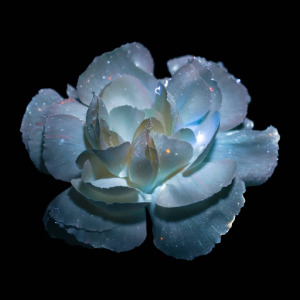
Photo by Debora Lombardi (My Modern Net)

Photo by Craig Burrows (CPBurrows.com)
Feral: As Tex points out, nothing is going to appear blue if the people of your world cannot perceive the wavelengths of blue light. Even without UV, this trick of light is a popular option. Bluejays (and all birds with blue plumage) actually have feathers that are pigmented brown where we perceive blue because of a specific way air gets trapped in them.
However, another way to manipulate the proliferation of blue in your world is through geology and mineralogy. Tweaking the abundance of certain elements and how they are incorporated into the biochemistry of your world will change certain colors found in nature.
You can make certain blue rocks and minerals more prevalent. Basalt, slate, limestone, and sandstone are all common rocks that can appear blue. The mineral glaucophane can be mixed with basalt to create the metamorphic rock blueschist. Thus, the earth itself can appear more blue, rather the generally brown color we tend to associate with dirt, rocks, and sand.
But metals and minerals are also very important in biochemistry as cofactors, nutrient minerals, and trace elements. Most people will know that iron is an important metal for humans because it carries oxygen in our blood stream, and this is why our blood turns red when it’s oxygenated - that’s what iron does. But crustaceans have a greenish-blue blood because the oxygen-carrier is hemocyanin, containing copper. Cobalt, important to Vitamin B12, is a nutrient mineral that comes to mind when I think of blue.
So what about the flora of the world?
Flowers and fruits get their coloration from two types of molecules: carotene and anthocyanin. Carotene pretty exclusively produces reds, yellows, and oranges. Anthocyanin generally produces reds and purples, but in the rare occasions a blue flower is produced, it can be due to a chemical complex called metalloanthocyanin, which contains magnesium, aluminium, or iron (or a combination).
For a more scientifically robust look at coloration in flowers, including options other than metalloanthocyanin, check out this article, “Natural Blues: Structure Meets Function in Anthocyanins,” in the National Library of Medicine’s Center for Biotechnology Information Journal.
34 notes
·
View notes
Note
hey so hi so i may or may not have gone insane abt mollusc blood/hemocyanin a while ago.
so. squid blood transfusions. could it happen????? they dont have blood types to complicate it because they dont have red blood cells or a hemocyanin equivalent (blue blood cells?) cause their blood protein is just dissolved in the blood. so like. could you hypothetically do a blood transfusion between squids. the world needs to know.
You have gone insane. And I did not give you permission to take me with you dammit! >:(
So, Squid Blood Transfusions, huh?
I fell down a research rabbit hole so lemme take this from the start.
1. What 'bout them blood transfusions?
So in order to take blood from a donor your blood types have to be compatible. Your blood type depends on the antigens displayed on the surface of your red bloodcells. The antigen receptors in you blood are located on the surface of B-Cells and T-Cells. If they recognise antigens not present on your own red bloodcells they trigger an immuno response (as to why a blood transfusion with a non-compatible blood type is so dangerous for you)
There are 36 different systems in which you have a blood type, the ones most relevant being the ABO and Rh Systems, these make up the blood types you know like A-, O+, AB-, ect.
Source
Interestingly, in fish only 3 Systems of blood types have been found, for example Tuna's blood can be sorted into the Tg System.
Source
2. What the fuck is wrong with squid blood???
The blood of most invertebrates is not red, they don't have red bloodcells and transport the oxygen through their body in different ways than us. Notably, Octopi, squids and cuttlefish use blue haemocyanin. This has lead to their blood often being falsely labelled as blue, even though its more translucent.
Source
Their blood also lacks an equivalent to T-Cells and B-Cells so it lacks the receptors as well.
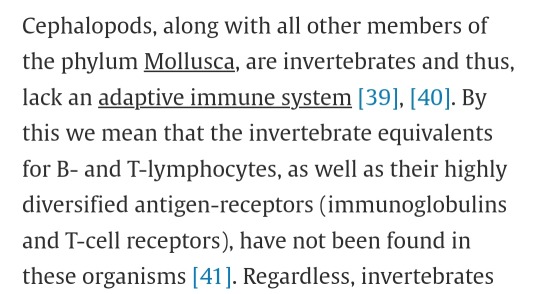
So Squids don't have blood types.
Source
3. But what if they get sick???
Cephalopods have a very efficient immune system, it's just very different to ours and barely understood. Research is still ongoing, but from what I've understood they have many different responses to health threats.
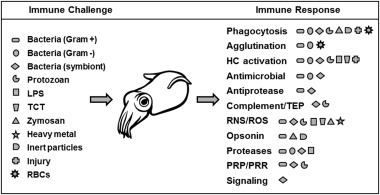
Source
4. So Squids can do blood transfusions?
Technically yes. From what I've figured. Though obviously theres other factors of complication that I might have overlooked/misunderstood and as I said the field is still very much left unexplored.
I'm very much not an expert in cephalopods (when I set my ask button to 'ask me about squid' It was more a shits and giggles thing, Im so sorry anon lol) but ive dedicated an evening to researching this and discussed it with my mum who studied medicine for what thats worth.
I hope I could affirm your theory, researching this was really fun. Also Anon u wanna be friends I don't think I can be normal anymore haha. \hj TT.TT
#sea creatures#marine creatures#marine biology#ocean life#marine life#squid#fish#ocean creatures#sea animals#ocean animals#science#cephalopod
10 notes
·
View notes
Text
Okay blood enjoyers! I come back with more thoughts.
I still need to see if I can find a resource on soft tissue injuries in cephalopods, because I’d prefer to use that as my model, but I’ve developed my own model in the mean time.
I’m assuming copper is an easy nutrient to find on Vulcan (n.b. I should address possibility of humans getting copper poisoning), so hemocyanin isn’t a resource to be conserved. The long progress of bruise healing is because humans conserve iron and recycle it, which is is hate been holding up progress, as there’s no comparison to heme for Vulcans to break down. If copper is not worth recycling, though — and given the vast quantities needed for the construction of a Vulcan-appropriate hemocyanin, I have to assume it isn’t — then it can simply be expelled as a waste product, which led me to my breakthrough: skin is a major source for releasing waste products. (That’s why garlic makes you smell.)
So with this happy decision under my back, I came up with quite a few consequences and notes on what that process might look like.
Bruises start very faint green, for reasons I’ll address in a bit. Almost like a soft flush. They grow brighter blue over time, and then fade away slowly (although the brightness of the blue doesn’t decrease) over time.
I’m also toying with the idea of forming a sort of “plaque” that eventually surfaces, similar to a human scab. I like this idea because it gives a suggestion of the shedding invertebrates have, but it might not be practical. It might be that Vulcans’ genetic ancestors (i.e., not ancient Vulcans, but the species leading up, like Homo erectus for humans) consumed these to regain the lost copper.
This is an itchy process, because it’s an irritant/foreign body under the skin.
I went with oxygenated hemocyanin because the alternative is a colorless bruise, and ultimately, that’s not fun for writers. After all, I started this whole process because I got tired of Spock always having green bruises, with no nods to the healing process that results in rainbows on humans.
To expand on “brighter” blue, I’m imagining an initial dark, purple-ish color, that grows into the bright blue of, say, hermit crab blood. I know skin and light diffraction play a part in what color blood appears, but I’m going to be honest, I don’t care enough to figure it out.
The color also narrows to a smaller and smaller spot, which impacts the appearance of it growing more vivid/opaque as time passes. This is not necessarily correlated with the site of injury.
Now, I’ve already established that there must be other elements in Vulcan blood to give it the green color, and I specifically didn’t want those to go through the same process as hemocyanin. That would be fluid, and desert animals generally take conserving fluid to an extreme.
As far as that goes, I’ve more or less decided to have the yellow blood serum contain other necessary blood parts. For Spock in particular, this includes a human immune system. I do have a few specific thoughts on how this impacts his healing process, but mostly they can be summarized as “lower risk for clots and abscesses, higher risk for infections going septic and serious blood loss.” I won’t be making those specific points because the impression we get is that Spock’s biology is mostly Vulcan.
Because of the fluid conservation, I imagine there’s some edema (swelling from fluid). How diffuse this is depends on the injury, but I don’t imagine it being very severe. More notable and long lasting than in humans, but nothing dramatic.
While the blue concentrates over time, yellow spreads. There’s a limit, but healing blood vessels requires some space.
Because a Vulcan immune system involves a lot of clotting, there is a risk of several things going wrong. More seriously, a blood clot could block off a vessel, causing tissue death. This is rare, and the more severe the bruising, the more likely it is to happen. More bacteria also increases this risk.
If bacteria enters the system near or through the wound, there’s a not insignificant chance of an abscess forming. Again, Vulcan immune systems operate primarily on a “cover the bacteria(/virus/etc) so it can’t do anything” principle, and walling off an area to keep an infection contained is part of that.
A bruise very close to the surface, and/or with lacerations (think: hitting concrete or gravel, where a bruise would form but there would also be superficial lacerations in the skin) may ooze slightly, as the fluid can’t be contained and/or may be contaminated. This can cause confusion for doctors, because bruising is a dry process for people.
Extreme bruising can put stress on nearby joints. Vulcans manufacture hemocyanin in their connective tissue, and right now I have joints as bearing the brunt of that.
This is responsible for the initial green, as the hemocyanin has not been separated from the serum.
So…while I do intend to do a bit more digging to see if I can find better grounding, I think for now this is a very workable model of bruise healing in Vulcans.
#mine#spock biology quest#Star Trek#this one gets the stek tag bc I finally hit an answer#I wrote this in a notebook in my biology class#but look my professor overexplains things#anyway#I couldn’t look anything up so this is much more my own reasoning#than the previous researched based posts#but I’m honestly pretty happy with this#it synthesizes a LOT of what I’ve learned#the stuff I didn’t even always talk about LOL#and probably in ways that are non-obvious
4 notes
·
View notes
Note
Chiss biology hours now since I need to get it out and I think you'd like it. Tell me off if you don't. Timothy Zahn while a wonderful author and creator is not a competent biologist or linguist. And there are some problems their biology has. The first one is how chiss are blue? Color in the animal kingdom is a whole can of worms but I have come up with three possible methods through which chiss could be blue. The first is that chiss are using hemocyanin as a blood carrier instead of hemoglobin. Hemocyanin is naturally found in invertebrates and uses copper to carry oxygen hence appearing blue. But chiss are very blue and human while using red hemoglobin are not bright fucking red. Hemocyanin would also make chiss blood and insides blue. But we know that they have red insides. Interestingly though, hemocyanin might be useful for living on csilla as hemocyanin is more efficient than hemoglobin at low temperatures. However, it is weaker at higher temperatures and this would make chiss sensitive to high temperatures, like pass out at 90 degrees f or less from heat stroke sensitive. Part 1.


hi anon, you now get to see the difference between me talking about linguistics (perhaps competent) and me talking about biology (flailing like a wet noodle). my silly thoughts are as follows
-yeah chiss being red on the inside is canon and also very important for dramatic visual effect
-ive thought of chiss skin as being like. blue pigmented. but a secret space blue pigmentation that removes the issues caused by proposing one of the ones that exists on earth 😂
-yeah i think abt the pupils issue a lot too LOL and am not really sure what to do about it ):
sorry this is super embarrassing of me but biology makes me feel so dumb 🤦♂️
edit: i think i saw someone rb some posts about this from @mayhaps-a-blog who has a lot better to say on this subject than i can 😅
10 notes
·
View notes
Text
Some Enderman Anatomy and Physiology that I've been messing with for a while. It's a lot of (probably incoherent) reading so I'm sorry in advance
Endermen have 2 circulatory systems: 1 Copper based and 1 Iron based
Copper Based -> Hemocyanin (actual blood type)
Hemocyanin is blue blood! and is found some deep sea creatures like horseshoe crabs, other crustaceans, and some cephalopods (found in creatures with little oxygen sources)
Hemocyanin binds to 96 oxygen (24x hemoglobin) which would make it great for creatures in the Void/End
Copper-heart primary functions: nutrient transport to the rest of the body
Iron Based -> a mix of Hemoglobin and other iron compounds
Hemoglobin is red and only binds to 4 oxygen, making it less efficient as a nutrient circulatory system (although it can still technically function as one)
Iron-heart primary functions: teleportation via manipulation of the magnetic fields (it takes a lot of energy to do so, stamina is built over time and use)
For proper teleportation, a reaction must occur between the 2 circ. systems. Therefore, these systems are closely interwoven throughout the body, creating a purple hue to the endermen
(Also, Copper-Iron master alloy is a thing: it's super strong & resistant to corrosion (which could give further explanation why endermen are strong), and is highly conductive with heat and electricity)
Okay, cool, but how could this translate over into already established endermen characters like Ran Aetherman (Bishops Knife Trick) or c!Ranboo (DSMP)?
Well, in BKT, it has already been established (chapter 8) that Ran is "missing a whole ass chemical" in his blood, giving reason as to why he doesn't function as a normal enderman would.
I'm deciding that chemical is found in the blue/copper system (I didn't bother trying to figure out what that chemical could be).
Okay, but when overlapped with the red/iron system, that would not make Ran green hued anymore. So consider another biology fuck up: Ran has a build up of biliverdin in his red/iron system, making both of his systems green colored.
So, a missing chemical + low hemoglobin ratio = improper teleportation
(A brief explanation of WTF biliverdin is: hemoglobin constantly gets recycled within our blood and goes through various stages. It first gets turned into biliverdin, which is a non toxic green compound. Then that is turned into bilirubin, a toxic yellow compound that gets flushed from the body via the liver (it's also what causes jaundice in people). It's possible for this recycling process to get stuck half way at the biliverdin point [ex: green-blooded skinks])
Cool, but what about Ranboo, who has very early on implied having red blood and green blood?
Well, I like the missing chemical idea a lot, as it keeps continuity (especially since BKT is with in the dsmp realm). But, again, the overlap of the systems would make Ranboo have a brown hue as opposed to his distinct split hue coloration
Building on my previous theory, that he's full enderman but the white is scarring/caused by extreme stress: something must have occurred (in development, a severe injury, idk, something) to cause his 2 systems to not interact and separate from each other.
This would explain why he can't teleport naturally, why Ghostboo's blood stains are divided so evenly
#I do a bit of research in my spare time#I'm gonna make a more professional looking thing on this later#I'll compile all of my sources in a bit#I've just been sitting on this idea for too long#funky minecraft universe concepts why not
7 notes
·
View notes
Text
According to Jhonen Vasquez during this InvaderCon interview (at 21:07), IRKEN blood has a clearish pinkish hue. I thought about what components would be necessary to produce this coloration while also being sufficient for their needs as endothermic oxygen-breathing vertebrates. I’ve researched the issue, and now I’m here to propose my conclusion: IRKEN blood contains small amounts of hemocyanin in addition to hemoglobin.
We may need to start with a little biology refresher: The vast majority of vertebrates carry hemoglobin in their blood- a protein containing iron found in each blood cell, primarily responsible for the distribution of oxygen throughout the body. Iron specifically, as opposed to other elements, is utilized due to it easily bonding with oxygen and its ability to carry up to 4 oxygen molecules, making it efficient at delivering ample oxygen. Since the iron in blood is already in the form of a compound instead of a metal, it can oxidize and still become red without rusting and poisoning us from within. Inside the veins, blood has lower oxygen levels, making it a darker shade. But, in the arteries it turns bright red because it has become more oxygenated. This is the same reason blood is bright red when outside the body and exposed to air.
With that explained, I can get to hemocyanin. Similar to hemoglobin, hemocyanin functions as a means of transporting oxygen in many mollusks, crustaceans, and larval insects, certain arachnids, and at least one species of centipede. The many inherent differences of hemocyanin usage stem from its use of copper as its oxygen-binder instead of iron. However, this type of oxygen transportation has only been seen in invertebrates so far, because of their lower oxygen requirements; see, unlike hemoglobin, hemocyanin can only hold a maximum of 2 oxygen molecules, the formerly mentioned protein generally being 4x as efficient as well. That wouldn’t be a huge problem if that was its only disadvantage, but hemocyanins are also larger than hemoglobins and unattached to blood cells, causing blood viscosity to greatly increase. With thicker blood, it’s more difficult for the heart to pump it through smaller vessels; the heart would have to use higher pressure (and with a warm-blooded animal, maybe beat faster as well?), which takes more energy and is harder on the body. Only cephalopods use this method of hemocyanin circulation, the more common alternative is to have an open circulatory system that allows hemocyanins to float suspended in the blood plasma. Despite the drawbacks entirely hemocyanin blood would pose for a vertebrate living above ground that wasn’t in a high oxygen atmosphere, it actually works well for small, ectothermic, simpler creatures, like arthropods, and even provides some advantages, those being efficiency in very cold temperatures, environments with low oxygen content, under high pressure (such as underwater), increased antimicrobial properties, and having much lower metabolic costs than hemoglobin.
It’d be unusual to see hemocyanins in a vertebrate’s blood, and the benefits of them would probably be nearly unnoticeable. But, back to the theory: if IRKENs did develop hemocyanin for whatever reason, how would the copper affect the color of their blood? Well, because of the copper, venous blood with just hemocyanin appears completely clear to translucent with a blue tint, and arterial blood is fully blue, sometimes with a tinge of purple. If IRKEN blood was composed of mainly hemoglobin with a tiny enough quantity of hemocyanin, it’d be a darker, more reddish pink with a clearness to it when deoxygenated and a brighter, more opaque, purer pink if oxygenated. They could have the hemocyanin floating in their plasma or have totally unique hemocyanin blood cells, which wouldn’t thicken the blood. If the former option, with a significantly higher ratio of hemoglobin to hemocyanin, the blood viscosity wouldn’t be so dense that their closed circulatory system would struggle to move it. Additionally, supplementing some hemoglobin with hemocyanin may reduce energy demands because of the fact that the [human] body is constantly producing red blood cells since each blood cell’s life span is 3-4 months, whereas hemocyanin’s protein structure can remain stable for years. They’d need a slightly higher copper intake in their diet to maintain their hemocyanin levels, but that doesn’t seem like it’d be a big issue.
#im not a biologist or chemist so im not sure how compatible iron and copper together in blood would be#invader zim#irkens#irken biology#irken anatomy#headcanon#irken headcanon#invader zim headcanon#analysis#invader zim theory#theory
106 notes
·
View notes
Text
Uhhh blood colours and shit??
I saw a post on black bloods and I wanted to make my own post about blood colours that’s probably full of mistakes because I'm going off of shit I already have sources for and offhand knowledge.
Honestly, you can pretty easily excuse black-appearing blood as an abnormal amount of methemoglobin, a form of hemoglobin that has been oxidized but doesn’t bind oxygen. Blood from methemoglobinemia appears almost black when drawn into vials and is like a dark brown when laid out
Example of what it looks like can be found in Figure 2 in this case description and diagnosis of hereditary methemoglobinemia in a cat(who is now perfectly healthy after treatment).
Hemerythrin/Myohemerythrin and Hemocyanin was mentioned in the post and some of it was wrong so uhhh more info
Hemerythrin/Myohemerythrin are non heme oxygen carrying proteins that are mostly colourless until exposed to oxygen, then they turn violet/pink. All of the complicated shit is mostly explained here but the takeaway is that it’s violet/pink.
Hemocyanin is copper containing and appears blue when oxygenated and also mostly colourless when in its deoxygenated state, and all of that is even more complicated and I literally cannot explain it so go here for that.
There’s another one called chlorocruorin that CAN appear green, usually only in dilute solutions but red in concentrated solutions. Wow these explanations are getting shorter and shorter the less I know about them so go here and here for more info on that, or google it idk.
You want another weird blood colour and an excuse to make a white blood? Here is an article about an ice fish which literally evolved to get by without hemoglobin.
TBH you can probably mix some of these and get pretty close to black blood without methemoglobin but how that would function on a biological level and what impact that would have I have no clue.
#.txt#talking cadaver#cadaver canon#have fun with this knowledge#That's my contribution to the FTC#ask to tag#text heavy#long post
16 notes
·
View notes
Text
I have no idea how I got 11 followers, but here you all go. A beautiful gift just for you that is 100% not what you followed for.
That's right, I'm here to talk about octopods. Because the plural of octopus is octopods, though octopuses is also acceptable. Octopi is wrong, as it applies Latin pluralism to a Greek word.
I really like them, okay? They're just.... really cool. Like, really cool. So I'm spamming facts.
~~
When you think of 'octopus,' you think of eight legs, right? Well, that's not universal. A species was found with only seven.
They also have three hearts. Three of them! Like. Three hearts. And the have blue blood in those hearts. Blue blood. Do you understand how cool this is?? It's because hemocyanin carries oxygen better than hemoglobin in cold, low oxygen areas.
Octopods branched away from humans (and all other vertebrates) so long ago that no one had invented eyes yet. Think on that a moment.
Moment over? Great, let's talk venom.
Contrary to some claims, all octopods are venomous. However, very few are even noticable to humans. But. Huge exception is a blue ringed octopus. Like. HUGE.
These octopods. They just. They are the size of, like, golfballs. Yet, they have enough venom to kill 26 adults contained in each bite. And there is no antidote. The bites are also completely painless, so likr. Some people don't even notice they're dying? They use tetrodotoxin, same as pufferfish.
They really make up for the fact that no other known species is fatal.
And then. And then.
The brains. Octopus brains. They don't have a single brain. Nonononono, that would be too normal. Each tentacle has like, its own psuedobrain that can think, feel, taste, and move independently from the rest of the body.
And yes, taste. They taste through their skin. They also regrow their arms, so that's really cool. Sad fact though: the tentacles normally live about an hour after the body dies. They will still catxh food and place it in the unresponsive mouth... 😢😢💔
The most common octopus, often called the common octopus, has the scientific name Octopus vulgaris. Which just. Is beautiful? Magnificent? Just. That name. 10/10.
Many people know they change colors, but like. Did you know they can change in the blink of an eye? Like.

[Image ID: A gif of a small white octopus doubling in size and turning blue in about one second. End ID.]
If you see, they also change size and texture? Like. Look at that. That's real time. Phenomenal. Just. Wow.
Each chromatophore skin cell has a flexible sac filled with pigment, called cytoelastic sacculus. If the muscles around tense, they stretch, so more color is visible in the octopus’ skin. This will give them a brighter color. On the other hand, if they relax their muscles, the sacs shrinks back to their size, so the pigment is less visible. Just like irises in humans (and many other animals).
But if an octopus turns white, that means it's frightened, so just. Leave it alone, okay?
Although there is an ongoing study about some octopus species showing social skills, octopods are typically non-social creatures and they prefer to live alone in dens that they made out of rocks. Female octopods also tend to eat stray male octopods of their own species. Maybe that's why studies show nearly all octopods are bi...
Oh! Back on eyes real quick? Yeah, so, they have better eyesight than humans. Or, even raptors (the birds, I don't know about dino eyesight).
They only live about 1-5 years (depending on the species), so that's also kinda sad.
So yeah, that's my octo rant.
If anyone has anything to add, or disagrees with something I said, I'm happy to hear your part! My facts come from various sources, and I'll believe some are incomplete or poorly worded.
10 notes
·
View notes
Text
Kingdoms ch. 69
Wade watched the faces of the people in the room with a smile. Demanding to be sent home was Peter’s idea. Having Peter walk into the room that Steve, Bucky, Tony, and Pepper were in carrying both of their travel bags (now even bulkier with the gifts they’d gotten from people in Mysterio) while Wade only carried the two spidlings was Wade’s idea. The looks on their faces was priceless.
“Hold on,” said Bruce slowly, “there’s a lot about the entity that we still don’t know.”
“We know,” said Peter with inescapable logic, “that the war is going on. We know that we’re all still being attacked. And as much as I’m enjoying the stay here, we need to go back home.”
“Yes,” agreed Steve. His advisers looked at him and he met their gazes squarely before turning his attention back to the ambassador. “You now know,” he said slowly, “how our mix of magic and technology works. Soon we’ll have to take to the field to support Arachne against Ajax.” He paused and then met Peter’s eyes again. “I’m counting on you to take our abilities into count when making your strategy.”
Wade expected Peter to demur, to say that Harry was the one who made military strategies, but the omega simply nodded. Tony sighed. “Kid,” he said solemnly, “it’s been a pleasure.” Tony looked at Wade. “You’ve been an ass.”
Wade nodded just as solemnly. “Of course,” he said simply as Pepper smacked her mate’s arm. The pink spidling in his arms jumped down, raced over to Pepper, and jumped in her arms before rubbing its head under her chin and running back to Wade.
Pepper smiled warmly. “Aw,” she cooed.
“Creepy,” said Tony staring at the baby spiders.
Bruce sighed. “Well,” he said as he stood up, “it’s simply not possible to open the Crystal Gate in this room. Please follow me.”
“How does he do that?” whispered Tony as Peter adjusted the two giant bags slightly and followed Bruce.
Wade simply grinned at the man and followed his mate, the two baby spiders in his arms making content noises. He knew that one of the most surprising things about the spiders, to the uninitiated, was the noise. They were almost always making some kind of communicative noise. Wade loved it.
“I figured out why the venom is good about protecting from insects,” Bruce commented as the three of them traipsed through the halls. Well, Peter and Bruce were walking. Wade was partially dancing—he wanted to go home too, home to his and Peter’s rooms in the temple where the stone was thick enough that no one heard anything going on in the bedroom.
“Why?” asked Peter.
“Inside the insects is a molecule called hemocyanin, which allows the insects to exchange oxygen and carbon dioxide,” lectured Bruce.
Wade simply nodded. He didn’t know if Peter knew what the man was talking about, but he was clueless. The back of Peter’s head seemed interested.
“The way that the—the red blood cells do for humans?” asked Peter eagerly.
“Erythrocytes, yes,” said Bruce with a nod. “There’s a protein in the venom that breaks the bond of the hemocyanin molecule.”
“So, it suffocates the insects?” asked Peter curiously. Wade could only grin at the mix of curious, happy, content from the bonding mark. Peter loved learning.
“It does. It also, for some reason that I haven’t been able to understand, stimulates collagen, which is why it’s good for skin as well.”
“What’s collagen?” asked Peter.
Wade let the rest of the conversation wash over him. He didn’t really need to know as he followed them to the room that the two of them (four, including the baby spiders) had arrived in. Still lecturing, Bruce set up the Crystal Gate and Peter calmly tossed the baggage through—and then looked at the gate with a dawning expression of horror.
“I’m sure everyone cleared out when the magic portal opened in the middle of the room,” Wade reassured his mate gently. The red and blue baby spider jumped from Wade’s shoulder to Peters and gently nibbled on his ear with its mandibles as it made a soothing croon.
“It’s done now, anyway,” muttered Peter. He shook himself all over. “Thank you, Bruce,” he said holding out his hand in the Mysterio custom as he met the man’s eyes. “I know it couldn't have been easy to teach someone like me.”
“Nonsense,” said Bruce breezily as he gently shook the omega’s hand. No matter how strong Peter proved himself to be, there was something in the biology of those from Mysterio that said omegas were to be treated gently. Wade, for the most part, agreed. “You’ve been a real pleasure. Especially after having to deal with entitled little brats who think they already know everything.”
“I don’t think Tony would appreciate you calling him that,” advised Wade.
Bruce merely chuckled and offered his hand to the alpha. “Take care, Wade,” the man said meeting his eyes fearlessly.
Wade bat his eyes flirtatiously. “Who, me?” he asked.
Peter gently nudged him. “Watch it,” he warned affectionately, “or I might get jealous.”
Wade crushed Peter in a hug, both baby spiders squeaking in indignation as they moved out of the way. “Perish the thought,” he murmured. Peter laughed and after a final goodbye, the two of them stepped through the gate and towards their home.
7 notes
·
View notes
Photo


I have More Lore Thoughts on Reykal and Alivar's several-years-long "adopt a child of another species, they said. It'll be fine, they said" crisis, featuring a very specific headcanon about a Togruta rite of passage. This is a long post, hit J on desktop to skip.
Alivar really does try his best to research Togruta culture and customs - including their spiritual ties to hunting, something more or less foreign to him as a Mirialan. Have a headcanon ramble: when Togruta turn thirteen, or roughly the equivalent in Shili years, they're traditionally taken on their gul'atai, usually translated as "first hunt." When Reykal's about six months from turning thirteen, Alivar starts panicking as he's trying to research it realizing he cannot find enough information on the Holonet to do it justice. Instead, he spends almost a month trying to track down an adult Togruta to teach him about the gul'atai and how he can give that to Reykal. What he learns:
- "First hunt" is a mistranslation, sort of - it’s more specific than that; Togruta have a lot of words for “hunt.” Young Togruta start going out on small game hunts (think space rabbits and fowl) with their tribemates at a much younger age. The gul'atai is their first hunt of a feast animal - a prey animal large enough to feed the entire tribe for at least one meal.
- The hunt starts on their thirteenth birthday, but it's not unusual for it to take the hunting party (much larger for a gul'atai than basically any other hunt, so as much of the tribe can witness the kill as possible) several days to track down a feast animal and get it in a position where they can make the kill.
- Togruta, much like humans and wolves, are largely pursuit predators, although they will ambush prey if they can. This is unfortunate for Alivar, since Mirialan blood is actually less efficient at carrying oxygen than most humanoid species in a warm, high-oxygen environment in my headcanon*, and he thus absolutely cannot keep up with Reykal's endurance, but he decides he'll cross that bridge when he comes to it.
- The skinning, cleaning, and butchering of the carcass are all part of the gul'atai and the young hunter will participate in the process. (This is fortunate for Alivar, since he barely knows anything about that, and at least they'll struggle through it together.)
- There are several species that qualify as "feast animals" even just on Shili, much less in the wider galaxy, and so there's some significance to the type of feast animal a young hunter kills on their gul'atai - the spirit of that animal is said to stay with them throughout the rest of their life, appearing in their dreams to warn them of danger or predict events in the near future. (Alivar doesn't really understand why something you killed would stick around to give you advice, but he also doesn't really understand Togruta views on the predator-prey relationship, so.)
- Every part of the animal is used - meat, hide, horns, bones, etc. This is standard for all kills, not just the gul'atai.
- The young hunter takes something from the animal - a horn, a tooth, a claw, a hoof, etc.; something hard and preferably sharp. This is a kind of trophy, proof they've fulfilled this rite of passage, but it's also a reminder: just as you are the hunter, so too will you one day be the prey. All things are hunted, and all things must eat, and all things must die. It's a reminder to be respectful of your prey, that you might also die cleanly and with honor one day.
- The night after is a massive feast, nothing held back. The entire tribe eats together, and the night is for songs, stories, and boasts of the young hunter's prowess in the gul'atai. Their tribemates spend large portions of the night boasting about the young hunter's skill, talent, and courage in the hunt. In killing a feast animal, they've provided for their tribe probably for several days at least, if not weeks or months once the leftover meat from the feast is preserved for later eating; this is a great honor and worthy of celebration under any circumstances. (In modern times, it's also usually the first time the young hunter is allowed to try alcohol, although overindulging is usually discouraged.)
Alivar proceeds to spend the remaining months until Reykal's thirteenth birthday preparing - recruiting people he knows who are better hunters than he to help guide her, researching planets where animals that fit the criteria for a gul'atai can be found (both large enough to qualify as a feast animal and not so dangerous that they're likely to be lethal to a young hunter on their first big game hunt), learning how to do things he has no idea how to do, and most importantly keeping it all secret from Reykal herself until only a few days before. (She cries, because of course she does, and then absolutely kicks ass during the hunt itself, because of course she does.)
Reykal’s gul’atai beast is a haska, which is actually an animal that exists in Star Wars canon if you want to look it up. She took its tusk as her trophy-slash-reminder (I’m sure there’s a word in Togruti for it, but I haven’t come up with it yet.)
* This comes from my "Mirialans have blue blood" headcanon - hemocyanin is more advantageous in low-oxygen, low-temperature environments (which is what I subsequently headcanon Mirial as being like), but it's actually less efficient than hemoglobin at carrying oxygen in oxygen-rich, warm environments like most livable planets in Star Wars. (You would think that the Mirial environment headcanon came first, but no, all of this came from me going "hehe funny-colored blood machine go brrrrr" and then sorting out the consequences and implications of that after the fact.) As a result, Alivar absolutely cannot keep up with his Togruta daughter’s endurance even when she’s younger than him. She finds this hilarious.
(Image Description: Two pencil drawings. The first is of a haska, a large, bulky, quadrupedal animal on four stout legs with toenails and feet-pads like elephant or rhinoceros feet. It has a long, thick tail, a roughly rounded head, and two large, relatively straight tusks. The haska has stripes all the way down its back. Text reads, “Reykal’s gul’atai beast (canon animal).”
The second image is of two characters. On the left and in the foreground is Reykal, a Togruta woman with tattoos on her forehead and the inner corners of her eyes, sitting in profile to us. She holds the tusk of the haska, a little longer than her forearm, up in front of her face, examining it with her brows slightly furrowed. In the background on the right, Torian Cadera from SWTOR stands in the doorway, looking in at her questioningly and asking, “What is that, anyway? I’ve seen it on your wall before.”
End ID.)
#star wars#swtor#swtor ocs#bounty hunter#torian cadera#headcanons#togruta culture#reykal#alivar#smuggler#characterization rambles
13 notes
·
View notes
Note
Squid?
Okay so squid is a broad category and I wasn’t sure which one you would want, but I think Vampire Squids might work! Co-wrote by my cat Harley.
Unfortunately, vampire squids have nothing to do with vampires, sparkly or otherwise. Lame decision the universe’s part if you ask me. The origination of the name though comes from it’s deep red color to jet black color, milky bluish/redish eyes, and the spines on it’s webbed tentacles. It was assumed that it sucked blood out of it’s victims with them, but in fact it was a defense mechanism, the squid would flip it’s webbed tentacles up around itself and the spines would stick out, making it unpleasant to try and eat it.
They live in tropical waters, about 600-1200 meters under. It’s quite dark down there, and has little oxygen which means little food, but they manage to get by. They aren’t active hunters, they eat Marine Snow, gathering it up into a ball and then bringing it to their beak.
Being like most cephalopods, they must keep an blood-oxygen saturation of 50%, but their habitat is only about 5% saturated. To cope, they have bigger gills and hemocyanin, a copper based blue blood that binds to oxygen better. Those are used in combination with not using much energy and metabolize slowly.
Unlike octopods, vampire squids do not tend to their young and can reproduce after mating once. Far less dramatic, which is better biologically but not emotionally. And unlike other squids, they do not ink.
They aren’t very big at only a foot max in length. Females tend to be larger than males as well. They babey.
What’s even better is that they aren’t endangered, or threatened! They pose no profit to humans and live too deep to be noticed often. These little guys are awesome and need to be protected from ever being endangered.
6 notes
·
View notes
Text
Cuttlefish have three hearts, green-blue blood and horizontal vision that allows them to see behind them
Cuttlefish have not one, not two, but three hearts! Two hearts are used to pump blood to the cuttlefish's large gills, and the third heart is used to circulate oxygenated blood to the rest of the body. Speaking of cuttlefish blood, even that's interesting. According to New World Encyclopedia, "The blood of a cuttlefish is an unusual shade of green-blue because it uses the copper-containing protein hemocyanin to carry oxygen instead of the red iron-containing protein hemoglobin that is found in mammals."
In an effort to hide from predators, cuttlefish can mimic the shape and texture of objects around them. Their close relative, the octopus, is also able to do this. Cuttlefish accomplish this texture change by extending or retracting tiny bumps called papillae located across their bodies, and thus better match sand, bumpy rocks or other surfaces where they're hiding.
Cuttlefish males disguise themselves as females to get past competing males to mate with a female. According to Mental Floss, to woo a female without attracting competing males, "wily male cuttlefish employ some tricky gender-bending camouflage. With one half of their body they put on a colorful display for the female's benefit. With the other half, they disguise themselves as another female, mimicking the muted tones of the female they're courting so as not to attract the attention of nearby males." But that's not all they'll do. If a male isn't as big and tough as other males vying to mate with a female, then he'll rely on cunning and stealth instead. A male will mute his colors, position his body to look like a female carrying eggs, and use this disguise to sneak past competing males for his opportunity with the female.
Cuttlefish have truly impressive vision, including the ability to see what's behind them — completely. According to PBS, "It can see well in low light and can also detect polarized light, enhancing its perception of contrast. While we humans reshape our lenses in order to focus on specific objects, the cuttlefish moves its lenses by reshaping its entire eye. Also, the cuttlefish's eyes are very large in proportion to its body and may increase image magnification upon the retina, while the distinct 'W'-shaped pupil helps control the intensity of light entering the eye.”
Cuttlefish count better than most human babies. A study out of the Royal Society found that 1-month-old cuttlefish could easily tell the difference between a box with four shrimp and a box with five shrimp. By contrast, 1-year-old human babies can only determine a difference between piles of one and two and piles of two and three, but no higher than that. When the boxes contained more shrimp, the cuttlefish took longer to decide which box to eat from, and researchers took this as a sign that the cuttlefish were physically counting the number of shrimp before making their decisions.
Cuttlefish are perhaps best known for their ability to almost instantly change color to match their surroundings, even as they swim through different colors of coral or rocks. What's more, is the coloration doesn't have to be static. They can change color in rapid patterns that make it look like ripples of color are rolling over their bodies. The mesmerizing "light show" effect is a strategy that can help cuttlefish catch prey. This detailed color-changing ability is even more impressive when you consider that cuttlefish are colorblind!
998 notes
·
View notes
Text
Cuttlefish --not so cuddly
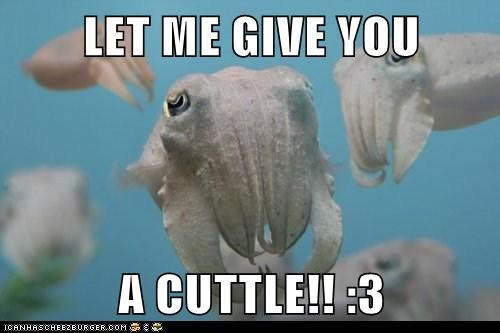
I. Classification
Animalia
Bilateria
Protosomia
Lophozoa
Mollusca
Cephalopoda
Coleoidea
Sepiida
Sepiidae
Sepia
officinalis
Integrated Taxonomic Information System, Sepia officinalis (Linnaeus, 1758)
II. Biology
Vagabond Lifestyle
The Sepia species can be found across temperate and tropical seas except off the coast of the Americas. A range of species can be found in Asia, Europe, Africa and Australia.
Each species of sepia live in either tropical or temperate waters. They are saltwater dependent so they all inhabit the ocean. They can either live in shallow or deeper waters (as low as 2,000 ft beneath the surface). Some species migrate from warm to colder temperature as the seasons change.
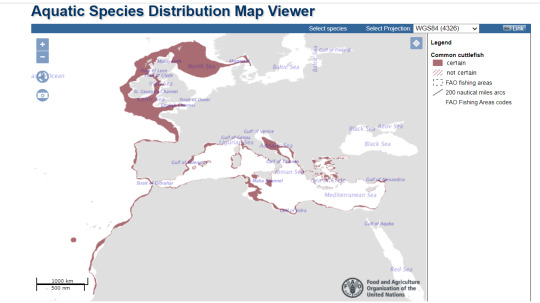
Image retrieved from fao.org
Armed and Dangerous

The Cuddlefish Cuttlefish has 8 arms along with 2 tentacles. These are specialized for holding on to prey like fish or shrimp. It lures prey by altering its skin color while waving its arms in a mesmerizing fashion to draw in unsuspecting prey. When the prey is near enough, its tentacles shoot forward and entangle the prey. The arms of the cuttlefish also has the ability to suck in water into its mantle cavity in order to appear larger when trying to ward off predators.
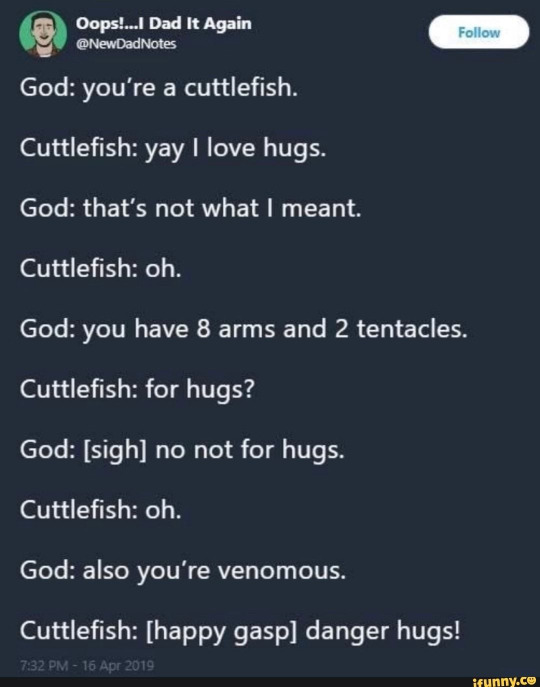
Beak
Much like a parrot’s beak, this is used to subdue prey or as a last defense towards predators. It lies deep in the base of the 8 arms of the cuttlefish. Beaks are one of the characteristics scientists use to identify species from each other.
Big Brain Energy

What makes this organism diverse may be attributed to the size of its brain. It is considered as one of the largest of any invertebrate. It can handle a variety of inputs from different senses like sight,smell and “sound” caused by pressure waves. Based on various studies, the cuttlefish can use visual cues in solving mazes. They are considered as intelligent as octopus and pigeons.
Cuttlebone

Image retrieved from: https://www.pbs.org/wgbh/nova/camo/anat-nf.html
Cuttlefish can control their buoyancy! Through their cuttlebone, a porous internal shell, they can adjust gas levels in the forward chamber and water level in the rear chamber, to control the buoyancy to rest in the water column.
Eye see you

Image retrieved from: https://www.pbs.org/wgbh/nova/camo/anat-nf.html
The cuttlefish is considered to have the most highly developed eyes in the animal kingdom. It is able to see in low light and can detect polarized light. While humans only reshape lenses to see, these organisms reshape their whole eye. It has a “w” shape on the pupil which helps control light intensity entering the eye. Cuttlefish have amazing eyes that can detect differences in polarization, and can shift its lenses forwards and backwards. They can see behind them!
Fintastic form

There are specialized fins on either side of the mantle that helps the cuttlefish reposition and glide through the water. It looks like a flouncy skirt when used to maneuver. It can help the cuttlefish go forward, backward and even in circles.
Early bird catches the worm. In this sense, the fins are used by smaller males to beat other larger males gain access to females.
More to Love
The cuttlefish has 3 hearts where two pump blood to the gills and one that circulates the oxygenated blood to its body. Its blood is a blue-green color because of hemocyanin, a copper containing protein that transports oxygen in most invertebrate bodies.
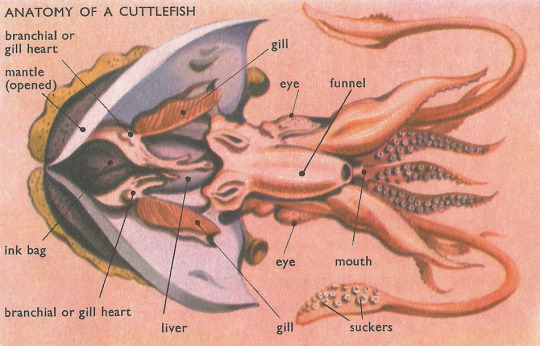
Image retrieved from: https://www.daviddarling.info/encyclopedia/C/cuttlefish.html
Secret Weapon
Since the cuttlefish is closely related to squids and octopi, it also has an ink sack that helps it ditch or distract predators who rely on sight. There are two ways to eject ink: one is to create a smoke screen behind the organism as it jets away or it can create a decoy by releasing ink in the form of pseudomorphs which are bubbles of ink surrounded by mucus that are about the same size as the cuttlefish. Dopamin and L-DOPA are present in the ink which can temporarily paralyze the sense of predators who hunt by smell.
youtube
Hairy details
There are lateral lines that consist of tiny hairs in the mantle of the cuttlefish that are sensitive to pressure waves. They are sensitive to 75 and 100 hz. These hair cells can be used as a defense mechanism by detecting movement of surrounding predators around the cuttlefish.
Mantle
Cuttlefish locomotion is heavily dependent on the mantle. When escaping predators, water is sucked into the cavity and the mantle muscles expel the liquid with great force so that the organism can move in the opposite direction. The water exits through the funnel which controls the angle of the spray. The mantle aids in respiration by bringing water up to the gills where oxygen is filtered and released into the bloodstream.
Reproductive organs
Males have a reproductive arm that inserts into the female’s buccal area, the area where the spermatophores are stored. Females accept more than one mate which leads the males to spray water through his mantle into the female’s buccal area to wash out other males’ spermatophores. Once ready to lay eggs, the female uses her arm to wipe the spermatophores onto the eggs.
Life as we know it
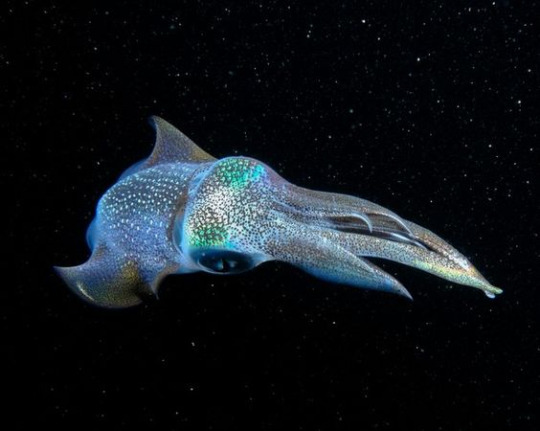
Image retrieved from: National Geographic Photo Contest 2019
In the springtime, after females lay their eggs they soon die. After two months, th eggs start to hatch. This process is highly dependent on water temperature. Once hatched, cuttlefish babies feed on small crustaceans and rapidly increase in size. Once big enough, the cuttlefish soon reach sexual maturity wherein the males mature much faster than the females. In ideal conditions the cuttlefish reach adulthood at 18-22 months. Their life span can reach 12-24 months
youtube
III. Relationship
Cuttlefish is an economically valuable marine species. Just like their cousins the squid and octopus, cuttlefish are a food source for humans. They are found in most temperate and tropical waters and the market for cuttlefish is large in Asian countries. In Japan, large cuttlefish are eaten raw as sashimi and the smaller ones are packed and frozen for cooking or sometimes dried (surume) (Nash & Thorpe, 2003).
The cuttlefish has an internal shell called the cuttlebone. This internal shell usually gets washed up to the shore and is picked up by beachgoers, collectors, and researchers. There aren’t many uses for the cuttlebone. Research on the effectiveness of cuttlebones as a supplement for caged birds are limited. However, from the research of Galal (2019), cuttlebone meal as dietary supplements for Japanese quails improves egg number and egg laying rate. There is also an increase in fertility rate and the body weight of the chicks.
Oil is also harvested from cuttlefish liver. In a journal article by Meivelu Moovendhan et al (2018), the oil from the liver of Sepia pharaonis was evaluated for its quality characteristics and biological activity. They found out that the oil contained Vitamins A and E, and nine fatty acids. Among the fatty acids present, Linoleic acid, DHA, and EPA had higher amounts.
According to Mehanna et al (2011), cuttlefish are overexploited in the Southeastern Mediterranean waters. The 45-day closed seasons are not effective, rather, they suggest that trawl selectivity should be improved. Also, the protection of spawning grounds through the establishment of MPA is necessary for improving stocks.
IV. Did you know?
Cuttlefish are also called “chameleons of the sea” because of their ability to camouflage. They can change their color through the help of specialized cells in their skin called chromatophores. Aside from color changing, they can also mimic the texture and shape of objects around them. They extend and retract their papillae in their body to change their skin’s texture.
Male cuttlefish change its color to attract femates. They can multitask, changing the color of half of their body to attract mates, while displaying aggressive coloration on the other side to ward off other males. In order to get a mate, a male cuttlefish also do “cross-dressing” and disguise himself as female. Since females only have three pairs of arms, a male even hides his fourth pair of arms and pretends like he’s carrying an egg. A real master of disguise!
Cuttlefish can hypnotize their potential prey by displaying pulsating light and color.
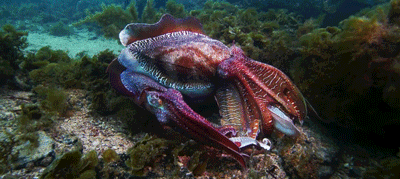
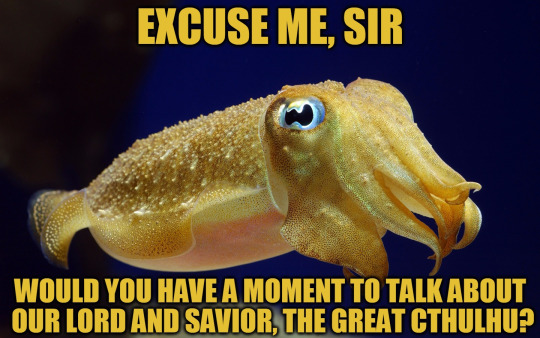
V. References
Compton, A. and L. Wiley (2011). "Sepia officinalis" (On-line), Animal Diversity Web. Retrieved October 08, 2020 from https://animaldiversity.org/accounts/Sepia_officinalis/
Geary, Daniel. (2015). Three hearts and blueish green blood… 10 fun facts about cuttlefish. Retrieved October 07, 2020 from https://atmosphereresorts.com/three-hearts-and-blueish-green-blood-10-fun-facts-about-cuttlefish/
Keyser, Hannah. (2015). 10 Colorful Facts About Cuttlefish. Retrieved October 07, 2020 from https://www.mentalfloss.com/article/66759/10-colorful-facts-about-cuttlefish
Mehanna, Sahar & Haggag, H. (2011). STOCK ASSESSMENT OF THE COMMON CUTTLEFISH, Sepia officinalis IN THE SOUTHEASTERN MEDITERRANEAN, EGYPT. Journal of Shellfish Research. 30. 1013-1013.
NOVA | Kings of Camouflage | Anatomy of a Cuttlefish (non-Flash) | PBS. (2007, March). Retrieved October 10, 2020, from https://www.pbs.org/wgbh/nova/camo/anat-nf.html
Reid, A., Jereb, P. and Roper, C.F.E (2005). “Cephalopods of the world. An annotated and illustrated catalogue of cephalopod species known to date. Volume 1. Chambered nautiluses and sepioids (Nautilidae, Sepiidae, Sepiolidae, Sepiadariidae, Idiosepiidae and Spirulidae).
Reproduction and Life Cycle. (n.d.). Retrieved October 10, 2020, from https://cuttlefishsepiida.weebly.com/reproduction-and-life-cycle.html
FAO Species Catalogue for Fishery Purposes. No. 4, Vol. 1. Rome, FAO. 2005. 262p. 9 colour plates. pp. 56 - 61.
4 notes
·
View notes
Text
Sorry but I'm more interested in learning about troll biology than I am intrested in actually paying attention to anything else. What the fuck makes blood all those colors? Hemoglobin makes blood red and hemocyanin makes blood blue on earth, but how the fuck do you get purple or green.
3 notes
·
View notes
Text
Rainbow Blood, and Why The Queen Isn’t A Lizard.
When we think of blood we think of that red stuff; but while red blood is the norm for us, it’s not for everybody. People often describe royalty as “blue-blooded,” and conspiracy theorists have claimed that royals are lizard-people. So, I’m going to take you on a journey through the many colour options for blood, and explain why if Queen Elizabeth was a lizard, her blood still wouldn’t be blue.
The red blood that we know and love is found in every mammal that we know of (or that I know of, if you know any exceptions, please let me know.) Haemoglobin is used in mammalian species to carry blood around the body and also contains iron, colouring our blood with it’s signature red hue.
Orange blood is the least wide-spread colour of blood in the life-sustaining rainbow. As far as I know, orange blood only occurs in pregnant cockroaches due to the creation of vitellogenin, a protein that is found in the yolks of eggs. Otherwise, cockroach blood is white or colourless.
Vanabin is responsible for the yellow blood found in beetles and sea cucumbers. In researching this I also learned that sea cucumbers aren’t plants but they sure are ugly. I was going to crack some joke about The Beatles and vanabin making them have a Yellow Submarine but The Beatles are surrounded by enough conspiracy theories so I won’t add any fuel to the fire.
There is actually two different pigments known to cause green blood and boy do I want green blood. The first pigment, biliverdin, is found in human blood and is what makes wounds and bruises turn green so all I need to do is get rid of all the haemoglobin an I can live my life as a plant sim. Biliverdin colours the blood of prasinohaema, a group of reptiles, green. Other reptiles have red blood so the two blood colour options for the Queen, if she was a lizard would be red or green, not blue. What’s more, if she was a hybrid lizard-human, human blood naturally contains Biliverdin so she’s just have red blood like the rest of us. The second pigment us chlorocruorin which is found in leeches, so I think it’s a possibility that The Queen could have green blood (see: the articles of the Magna Carta.)
The real blue blooded royalty are arthropods and cephalopod. The hemocyanin in their blood contains copper, which becomes blue when oxidised. If I had totally lost the plot and wanted to theorise that the Queen wasn’t human and had blue blood, my best guesses would be that she’s actually a spider-woman. Or an octopus-woman. [It appears that I have stumbled upon the characters for Spider-Man 2.]
I’m so glad that purple is the last colour I’ll be covering because this post is chaotic and thinking about the conspiracies about the royals have fried my braincells. Hemerythrin is a wonderful compound of sciency stuff that gives peanut worms and brachiopods (lamp shells) blood that is truly a royal colour. Apparently people collect and eat brachiopods because they’re easy to collect at low tide in New Zealand. Hope you enjoy your purple-flavoured sea weirdos, remember to use seasoning.
Overall, blood comes in a lot more colours than we think and next pride season you could have a rainbow of blood as decorations- you’d have a lot of explaining to do but it is a possibility.
I’m not certain I have to state this but I don’t believe that royals are inhuman (inhumane is a different story though) and I don’t think they have any colour of blood other than red. All that being said, if royals did have blood that wasn’t coloured by haemoglobin, their blood would probably be green because of the biliverdin that colours the blood of reptiles such as skinks.
I hope you’ve learnt something, have enjoyed my warped sense of humour ,and scathing remarks about the monarchy.
#lizard#conspiracy#conspiracy theory#science#blood#rainbow#pride#reptiles#arthropods#spiderman#royal#anti royalism#anti royalist#the queen#haemoglobin
1 note
·
View note